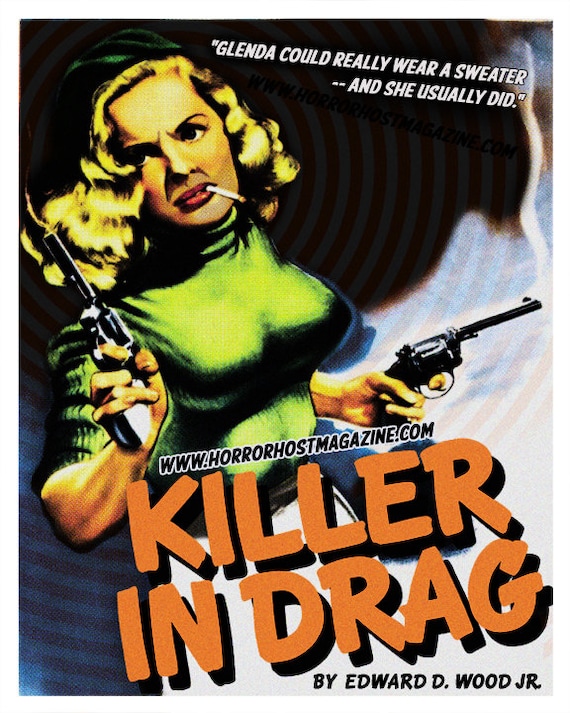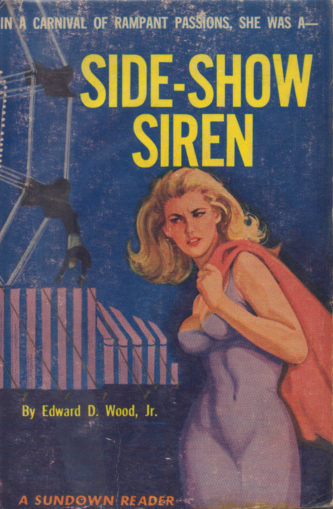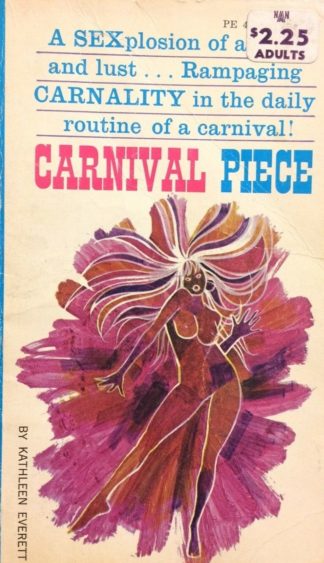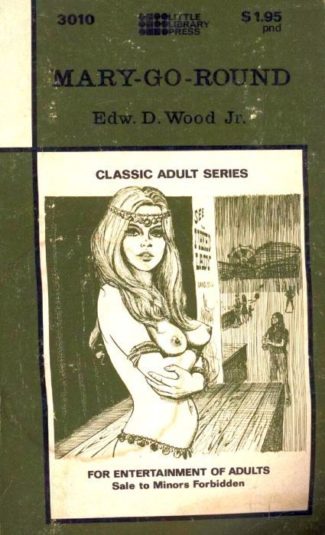
Ed Wood
Carnival life and Edward D. Wood, Jr. are two things that go together quite well. Wood certainly had the instincts of a carny in his talent for financing and exhibiting films that, as I’m sure we’re all aware, have been widely hailed as the “worst of all time.” This makes sense, as the man was in fact a carny in his early years. Of that period very little is known, outside some tales Wood told friends about how he indulged his cross-dressing proclivities by playing the part of the half-man, half-woman in a carnival sideshow. Proof of his assertions can be found in the details of carny life contained in several of his novels.
…the man was in fact a carny in his early years.
The true worth of Ed Wood’s 70-plus novels, written for the smut book market of the sixties and seventies, is (it can be argued) in the details they offer about their author’s bizarre life and obsessions.
 The first of Wood’s novels, 1963’s KILLER IN DRAG, is a gold-mine in this respect, with many autobiographical tidbits, among them a description of the setting up of a carnival—“Planks. Fresh lumber. Steel rods slammed to the ground…Banners began to appear over the entrance of the girlie show; the snake show; the western show, the Hawaiian show…”—that was used by author Rudolph Grey to detail Wood’s carny days in 1992’s NIGHTMARE OF ECSTASY: THE LIFE AND ART OF EDWARD D. WOOD, JR.
The first of Wood’s novels, 1963’s KILLER IN DRAG, is a gold-mine in this respect, with many autobiographical tidbits, among them a description of the setting up of a carnival—“Planks. Fresh lumber. Steel rods slammed to the ground…Banners began to appear over the entrance of the girlie show; the snake show; the western show, the Hawaiian show…”—that was used by author Rudolph Grey to detail Wood’s carny days in 1992’s NIGHTMARE OF ECSTASY: THE LIFE AND ART OF EDWARD D. WOOD, JR.
The true worth of Ed Wood’s 70-plus novels … is in the detail they offer about their author’s bizarre life and obsessions.
 Further carnival lore can be found in three subsequent Wood books, starting with SIDE-SHOW SIREN from 1966. The fourth or fifth of Wood’s novels, SIDE-SHOW SIREN contains a convincingly detailed description of the minutia of a travelling circus, with its many tents, each operated by different, though equally sleazy, individuals. Set down in surprisingly coherent, grammatically correct prose (unusual attributes for a late sixties Wood novel), it’s a lurid account of a nocturnal prison break perpetrated by Clay and Charlie, two sociopathic cons.
Further carnival lore can be found in three subsequent Wood books, starting with SIDE-SHOW SIREN from 1966. The fourth or fifth of Wood’s novels, SIDE-SHOW SIREN contains a convincingly detailed description of the minutia of a travelling circus, with its many tents, each operated by different, though equally sleazy, individuals. Set down in surprisingly coherent, grammatically correct prose (unusual attributes for a late sixties Wood novel), it’s a lurid account of a nocturnal prison break perpetrated by Clay and Charlie, two sociopathic cons.
Set down in surprisingly coherent, grammatically correct prose (unusual attributes for a late sixties Wood novel)…
Before the night is through these two loons will have stolen and crashed a police car, leaving Charlie dead. Clay stows away on a carnival train whose other passengers include Pat O’Hara, who’s in charge of the carnival’s gambling concessions; Herlie Berlie, who oversees the girlie tent; Jinx Dixon, who mans a sharp-shooting exhibit; and Duke Conners, who runs the freak show. Conners is particularly excited about an “abominable snowman” named Kari, a mentally impaired giant who becomes the primary suspect in the murders of a judge whose mangled corpse is left on a Ferris wheel seat, a police sergeant impaled by an antique sword in an African exhibit, and a district attorney found strapped to a carousel horse.
There are other suspects, including a sheriff who becomes unhealthily obsessed with the case and Donna, the freak show’s half-man half-woman (thus providing the requisite transvestite angle). It’s all suitably sleazy and exploitive, at least by 1960s standards. At its best the novel attains the heights of second-tier Jim Thompson, while at its worst it reads like—well, an Ed Wood novel.
It’s all suitably sleazy and exploitive, at least by 1960s standards.
As it turned out, SIDE-SHOW SIREN would set the narrative template for the following novels in this loose-knit trilogy, whose next entry was 1968’s CARNIVAL PIECE. Credited to “Kathleen Everett” (Wood’s wife’s maiden name), it’s immediately recognizable as a Wood text (and has been confirmed as such by Mr. Grey). Unfortunately it’s far less resonant than the previous book.
I know it’s wrong to expect too much from an Ed Wood novel, but I say CARNIVAL PIECE could, and should, have been lots better than it is. As in the earlier novel it begins with a killing at a travelling carnival, the victim in this case being a young woman who is horrifically slaughtered during an Arizona storm. The sideshow proprietor Jess Flow discovers the corpse in the downpour (during which “Jess found a lot of storms for his hot body”—yes, this is an Ed Wood novel!), setting off a sex-packed drama involving Charlie Overstreet, a sleazeball who runs the girlie tent; Shirlee, a beautiful nymphomaniac who comes to work for, and gets intimately involved with, Mr. Overstreet; Matty, a female impersonator; Mama Tate, an obese lesbian (a fact that by itself was apparently quite shocking back in ‘69); and Sherriff Cal Sweeny, who’s investigating the killing, and has a thing for Shirlee.
I know it’s wrong to expect too much from an Ed Wood novel, but I say CARNIVAL PIECE could, and should, have been lots better than it is.
Too much time is spent on the burgeoning relationship between Jess and Shirlee, and their frequent sexual trysts (which are graphically described but none too arousing). Far more interesting are the supporting characters, who include a human skeleton, a wolf man and a geek, but they’re not given much to do. The identity of the killer, as in SIDE-SHOW SIREN, is revealed in the final chapter, which is shockingly uneventful—a fault, no doubt, of the late-sixties adult fiction market for which Wood was writing, which valued carnality over plot twists.
The final novel of this overview, MARY-GO-ROUND, appeared in 1972, when Wood’s publishing career—and his life—was nearing its untimely end. It relates the debauched odyssey undertaken by Mary, a fetching 19 year old virgin who joins a carnival. The fateful murder that drives all three books doesn’t occur here until near the end, with much of the rest of the text taken up with Mary’s initiation into the grit of carny life, and her burgeoning relationship with Eddie, the studly proprietor of the girlie  tent.
tent.
The novel is far sleazier overall than its predecessors, a reflection of the state of smut publishing, which by the early 1970s demanded at least one explicit sexual encounter per chapter. Wood at least found some creative ways to fulfill that requirement, such as dialogue describing the encounters in question—as occurs in one early chapter in which a dude is overheard orating his every move as he has sex, and another in which a heckler describes to Mary in great detail the disgusting acts he wants perform on her. There’s also (once again) a side show she-male, who’s actually a normal man taking hormone treatments to make him look feminine, and who plays a large part in the climactic killing.
For the most part it’s a lackluster book, and easily the least of the trilogy. Taken together with its predecessors, MARY-GO-ROUND provides a depressing demonstration of how Wood’s fiction degenerated over the years.
Incidentally, Wood is said to have inscribed a copy of this book to a friend with the words “Let’s get a million budget and make this one into a film.” Obviously that never happened.
